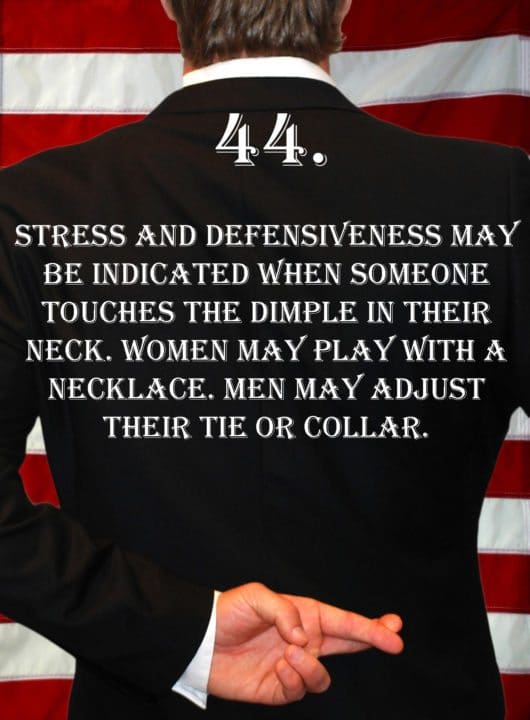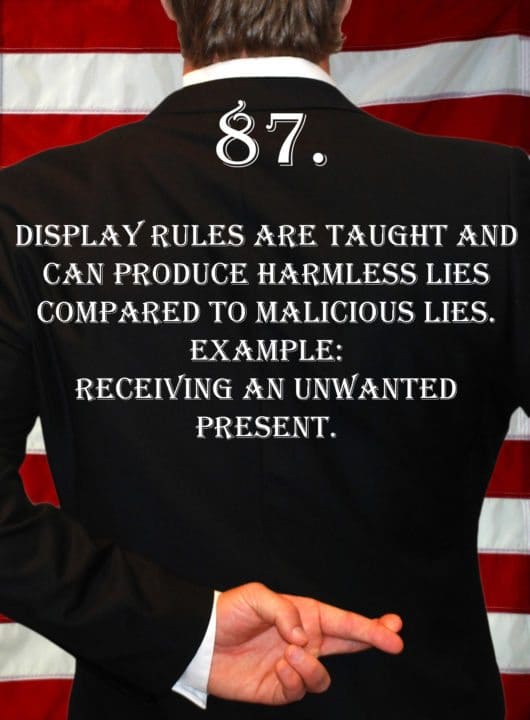
Deception Tip 50:
Occasionally, a liar may point him or herself towards the exit as if they are planning to escape from the situation.
Listen To The Podcast!
E50 – Towards The Exit – Deception Tips Podcast – Click Here To Subscribe
Podcast Transcript
Hello and welcome to the deception tips podcast where you will learn amazing cues to detect deceit that will help you read people like never before. I’m your host Spencer Coffman, let’s get started.
Welcome to episode 50 of the Deception Tips podcast. We are about halfway through these podcasts, we have a hundred and one deception tips that are all coming from the deception tips blog, which you can find on spencercoffman.com/blog. They are also on a new website called deceptiontips.com, where you’ll find all of these podcasts as well as all of the deception tips videos.
So, keep that in mind, check that out but remember all of these came from the deception tips blog which was the Deception Tips e-book and there are 101 of them. We are currently on number 50, so about halfway there, I hope you plan on continuing to listen over the next year as we make our way through these podcasts.
Last time, we spoke about a sign of deception that occurred in the legs, remember the legs are a very popular area for deception to appear. The reason is that so many people know that we watch each other’s faces. We make eye contact, we maintain eye contact, we look each other in the eye, and around and we mostly watch the upper body.
Therefore, the legs have more to show, and more to share. Why? Because people are not consciously trying to hide the behaviors on their legs, we learned about that in episode 47.
Last time, we talked about behavior on the legs, this was how liars may cross their legs at the calf muscle in an X-like. This was almost like folding the arms where you’re blocking off or you’re being a little bit withholding or defensive, but this is more direct, it is like a direct X.
Sometimes when people are in a situation, usually it’s when they’re joking, and they hold their arms up in like an X form like stay away from me or back away. It’s something like that with the legs, you’re crossing the legs, X the calf muscle and we also mention that this could be combined with some other behaviors of the legs that we’ve talked about before.
They were crossing the legs, that’s the first one with the calf muscle, but then it’s locking the ankles, also how they may tuck their feet back. We talked about locking ankles in episode number 22, so quite a while ago, but it is how they may lock their ankles to pull that stress and tension from their body. Then tucking backward, we’ve talked about that numerous times, pretty much throughout a lot of these different podcasts.
It is that they may tuck their legs backward to retreat from the situation. We talked about stepping backward in episode 29, and how they may retreat from the situation. Remember that anytime you see something on the legs it is a good place to watch for body language. The legs are going to be a lot more expressive simply because people are not consciously trying to hide the behaviors on their legs.
In addition, you always want to look for the patterns and clusters of behavior. So, when you see something happening on the legs, look for additional signs. So, crossing the legs at the calf muscle in the X, could be one, tucking them back could be another, locking those ankles could be another,
Typically, all that is considered somewhat of one behavior, but it could start a cluster. So, if you see other things in addition to that then you know that it could very well be part of a cluster. So, pay attention to the legs because they are a good place to watch for deception.
Today, we are going to talk about something in a different area of the body. That’s not entirely true because it does involve the legs. This is going to be something that you can see either separately in the legs or torso area or you can see it entirely with the legs and torso in unison.
So, this is one occasion where if you want to count symmetricality or congruent behaviors, it can’t really be symmetricality because it’s top and bottom and we’re not symmetrical that way anyway, but it could be more of a congruent behavior. This is one where the congruency does not need to be there so you can have the torso being separate from the legs or the legs being separate from the torso.
What you need to focus on is which one is performing the behavior because generally, one of them will and that’s more of an unconscious type behavior and it’s trying to lead the other one into that behavior. So, you may see the conscious keeping one part of the body in place because it’s polite and the unconscious leading the other direction, or you could see it on the full-body if the person really wants to get out of the situation.
So, here it is, this is deception tip 50. Occasionally, a liar may point him or herself toward the exit as if they are planning to escape from the situation. Here it is again, occasionally, a liar may point him or herself toward the exit as if they are planning to escape from the situation. So, as you can see, it could happen with the torso or the legs.
Let me give you a demonstration or verbal example of how that may happen. I’m not going to be able to show you, but you can visualize this in your mind. So, if someone is sitting in a chair, they could be in conversation with the person. Let’s say they’re in a group, maybe they’re in a ring of chairs around the circle, whatever the case may be.
Their torso, meaning their shoulder blades, that’s what you want to look at when it comes to the torso, it’s the squaring of their shoulders. Where are their shoulders leading? Not where are they pointing but where are they facing their chest?
So, if they have their body turned, swiveled towards the exit but their legs are still pointed towards the group of people, they may be trying to lead their body away from that situation, they may want to escape. Conversely, they may have their torso or their chest faced towards the group and their legs may be swiveled so that they’re pointing towards the exit.
Now, the legs pointing towards the exit, this is more of the knees pointing toward the exit and usually, both feet are flat on the floor. It’s almost like they are ready to stand up and go, that’s how this behavior looks in the legs.
So, we’re going to talk a lot more about this and a lot more about how they look and how you can see them and pick them out in some different situations coming up right after this.
Do you need to see it to believe it? Would you like to be a more effective communicator? If so, then we’ve got videos for you. Subscribe to the Body Language channel on YouTube for more deception tips.
Welcome back to episode 50 of the deception tips podcast. Once again, we are talking about how liars may point themselves toward the exit in an effort to escape or flee from the situation. What we were saying right before the break, is that sometimes it could be the torso that leads with this position or it could be the legs that lead with this position.
Whichever one, remember that they do not have to be congruent, however, if they are congruent, as in if the torso and legs are both pointing towards the exit then guess what, that person is pretty much checked out, they want to leave, they want to go.
So, husbands and wives, pay attention to your spouse because if you guys are ever at some sort of a dinner party or social gathering and you see one of them facing the exit in some manner or form. Whether you guys are sitting and it’s the legs or the chest or if you’re standing and they’re pointing that way, see if they want to leave.
Chances are they do, they just may not want to tell you, that is the polite version of this behavior. This is the unconscious’s way of being polite, this isn’t necessarily a full-on deceptive, lying behavior. They may be pointed toward the exit because they want to leave but they know that they can’t or that someone else they’re with, i.e. spouse, may want to stay.
So, they just go along with it but all the while they’re trying to leave because their body is pointing towards the exit, but they know they can’t leave. So, that’s a way that you may see it, it’s not a direct lie, although it could be considered a lie because they want to leave and they’re not sharing that with anyone. It could be a form of concealment which is a type of lying.
However, we would consider that more of a white lie or a polite, social lie, so nothing really serious. When it comes to deception, you may see this behavior when someone is in fact lying or when they are about to be caught in their lie. This would typically be found in some job interviews where someone may be slipping up in their story or their work history or something like that.
It could be an interrogation where they’re trying to get the facts of what happened or the story or the alibi and the police officer or whoever is interrogating the suspect is starting to catch on and trip them up. The suspect may be pointing towards the exit like, man, I’ve got to get out of here, and they may not be physically thinking that they need to stand up and run out of that room.
It’s more of a mental thing at that point where they’re like, I need to get my mind out of this situation so that I can come back to it and know exactly what to say so that I can get away with this lie. It’s more like they’re checking out for a little bit to come up with more stuff to convince the target of their lie. So, this is important, when you see this behavior, you must know that it doesn’t always mean someone is being deceptive.
However, it does always mean that the person wants to leave the situation or the area. It doesn’t mean that they’re having a bad time, they could very well be enjoying themselves. They may need to go to the bathroom, so they’re pointed towards the exit because they want to go to the bathroom, or maybe it’s something else, maybe their phone buzzed and they want to go check their phone, but they want to come back.
So, don’t necessarily think that the person is not having a good time. If you’re a teacher or if you’re a lecturer or you give seminars and you see people start to point towards the exit, their bodies, their torsos, their legs, whatever fashion you may see, if that’s happening, maybe it’s time for a little break. Let them get up and stretch, walk around, they’ve mentally checked out.
It doesn’t necessarily mean physically they want to get up and leave, it means their mind has left that situation, it is gone from that area. It’s daydreaming, it’s wandering, it’s thinking about what it’s going to do next, what’s for lunch, where am I going to go tonight, what kind of pizza do you want, that kind of thing, it’s not in the situation.
Therefore, if you’re a speaker, take that opportunity to keep people engaged and give them the break so they can come back refreshed. If you’re a spouse and you see this in your spouse, say, “Hey, do you want to leave?” Maybe they want to go out for a smoke break and have a heater, you never know.
Therefore, pay attention to this body language because it is truthful, they do unconsciously want to leave that situation. They may not even know why, so if you see that and they say no I don’t want to leave, I’m good, say, “Come on, let’s take a little walk.” Walk around, come back, boom, now they’re fine.
When you see this when you are questioning someone, then you definitely know they want to get out of the situation, which could mean they are being evasive. So, there are two things that you could do to try to get the truth when you are questioning someone, and they are showing this behavior.
Number one is you can keep them there because it makes them more and more uncomfortable. They become very nervous and the tension is building and building in them because they want to leave, they may not know why. It could be unconscious, they don’t even think about it but they want to leave and if you keep them there, you are increasing that level of discomfort.
Then you could use some of these other things like an awkward silence, we talked about that a long time ago, and how you need to stay silent. We also talked about becoming silent, those were a while back, we’ve talked about different things that you could do such as suggesting answers, things like that. Stay silent was episode 13, suggesting answers in episode 21.
So, if you haven’t heard them or you’re unfamiliar with them or you may not remember, go back and check them out. You can also check them out online if you just want to read about it, that’s fine as well.
Take that and use it to your advantage, make the person feel even more uncomfortable because the higher their level of discomfort, the quicker they may tell you the truth so that they can have that relief of “Whoof, I’m so glad I got that off my chest.”
Then their level of discomfort will go down, they’ll start to be more comfortable, the tension and stress will go away, etc. Make sure you point that out to them, “You’re only hurting yourself here, tell the truth and you’re going to feel so much better”, that kind of a thing.
The other thing that you could do to find the truth is you let that person get up, if you see that they want to go towards the exit, you say, “Hey, come on, let’s take a break.”
Walk them to the bathroom, go get them a soda, get them up out of there, walk them around then come back. It’s possible that their mind may need a break from whatever form of interrogation or questioning you’re putting them through, so maybe they need a break.
If it’s a criminal suspect, you probably don’t want to give them the break, if it is a job interview. Maybe it’s a character reference or just a general public thing where no one is really in trouble, then you probably want to give them a break so that you can get some better honest answers because you know that they’re not intentionally being deceptive with you.
Remember, watch where their body is pointed, and look for patterns and clusters of behavior. If their torso, meaning chest area, shoulders, are squared up towards the exit, or if their legs are open squared up towards the exit, they may want to leave. If they are entirely squared up towards the exit they most definitely want to leave.
I want to thank you for listening to the deception tips podcast, share it with your friends, subscribe to the feed, check out the deception tips videos, the blog, and take a look at the books I have available as always, tune in next week for a new deception tip.
Video Transcript
Hey guys, my name is Spencer Coffman, thank you for watching the deception tips videos they’re all about teaching you how to read people and detect deception so that you will be able to tell if someone is lying to you. Today we are talking about a sign of deception or a behavior that you will see either in one part of the body or another as in two halves of the body or you may even see it on the full body altogether.
It’s something that can happen when someone is standing or when they’re sitting, you’re going to see this when the liar is starting to feel a little bit like they are being caught in their lie. Like the tables are about to turn against them or the shoe is on the other foot or whatever other table-turning pun or situation you want to throw in there. This is happening when things are not going to go so well for the person who’s telling a lie.
The target is about to figure it out, they’re becoming wise and they are about to accuse the liar of that lie or catch them in the lie, so that liar is going to be caught. So, here it is, this is deception tip number 50. Occasionally, a liar may point him or herself towards the exit as if they are planning to escape from the situation. So, they’re going to point towards the exit, this is important, you may see this in, as I said, two areas of the body.
Their torso may be pointed towards the exit like if the exit is over here and the person, I’m speaking with is right here. I may be like, oh my gosh, I’m going to be caught in the lie so I’m no longer facing that person I’m going to square up my shoulders to that exit, but my head will still be turned towards the conversation or towards the person.
This is something that is subtle, you’ll see it with where people are facing typically when you’re in conversation with someone your shoulders are squared up to them. You’re facing them, you’re in a square, you’re in a box, it’s like if you see two people talking and they’re standing almost toe-to-toe or squared then it’s their conversation. If you see them and they’re talking and they’re open then a third person could come in and join that conversation, it’s the body language of openness.
So, if you see this and someone is talking and then all of a sudden, their shoulders are pointed away, they may be thinking, okay, I’m tired of this conversation, it’s time for me to leave. In addition, the other area of the body you may see this on is the legs, so someone’s hips or legs, like their knees, they could also be squared up with someone typically in conversation.
Their toes are lined up with their shoulders so their whole body would be squared up with whatever they’re doing, whatever they’re interested in, they’re talking to, they’re watching, etc. In this instance, you may see their legs, or their hips pointed away or they have one foot, one toe angled out toward the exit like they’re going to go. They may be shifting their weight like this, like alright 1, 2, 3, BAM, I’m out of here, they’re wanting to leave yet their shoulders are still squared up with the conversation.
If you see them entirely turned, their legs are that way, their shoulders are that way, they want to go, they’re out of there. So, that’s what you can watch for when this is occurring, the shoulders, the legs or knees, hips type of behavior area or their entire body. Again, this can happen whether they’re standing or if they’re seated.
If they’re sitting down then you may see, like if they’re in a swivel chair or something, they may be at the table, squared up with the table but the swivel chair may be turned so that they’re kind of going away. So, you can see this in standing liars or seated liars, it’s all in where their body is pointing, where they are framed up and wanting to go. If they’re going towards the exit, then chances are they want to escape or flee that situation.
Whether they’re just bored with the conversation and they want to get out of there or they’re lying and they’re about to be caught, that is up to you to determine from the context of the situation and what else is happening around there. If you see that they’re in a heated argument or a debate or they’re being questioned or challenged then you know that man, they just want to get out of that situation because they’re about to be caught.
If you see that someone is just talking on and on and on and this person is standing there, they’re looking at their watch. Maybe they’re looking up, they’re looking down, now they’re facing the exit, you’re like well, that person just needs to be rescued, they want to get out of that situation. There are different circumstances that you will see, and you need to know the context of the situation before you can make that judgment on whether or not that person is telling the truth.
So, if this is your first time watching these videos, I’d love to have you subscribe to the channel on YouTube, feel free to comment with any questions as well. Also, if you’d like more information there are books, blog posts, and podcasts all available on spencercoffman.com that are all dedicated to teaching you exactly what every body is saying.
Until next time.






